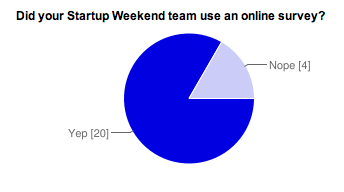Tips for Using Online Surveys at Startup Weekend
I saw a lot of online surveys flying through my In box at the last Startup Weekend Seattle. As the former product manager for online survey software (first at NetReflector, then at GMI), I saw a lot of common mistakes. Here are some tips for using surveys effectively.
 An online survey should NOT be your main source of customer insight
An online survey should NOT be your main source of customer insight
Hopefully you know this already. Customer validation is hugely important in any startup, but you’ll get far more insight by getting out and talking with people than sending an impersonal survey. Anyone pitching an idea should already have done a lot of this. If not, get cracking! Don’t let the abbreviated time frame deter you. Send a few team members out into the world first thing Saturday and start talking with people.
Focus on your target market
Surveys can be useful for validating your anecdotal feedback with a larger audience. But make sure it’s the right audience. Don’t just blast it out to everyone (least of all your fellow Startup Weekenders, who are really busy and probably not your target market anyway). Use the Google. Find 100 popular bloggers and tweeters who write about your market. Comment on their posts. Tweet to them. Get their opinions and ask them to distribute your survey.
Hook people into taking your survey with a provocative question
Don’t just say “Please take our survey”. No one cares about your survey. But they do care about the problem you’re trying to solve. Phrase your tweet or email subject line as a question that simultaneously grabs their attention and identifies them as sufferers of the problem you are trying to solve. “Want to shorten your commute?” “Do you think weather sites suck?” If they take the bait, they just answered the first, most important question of your survey: Are they your target market?
Keep it short and fun
Once you’ve got them, you need to keep them engaged. Keep your survey mercifully short. Put it all on one page so they can see at a glance how short it is. Reward them for their time with entertaining questions and answers. Make them want to answer the next question so they don’t miss any of the jokes.
Recruit beta users
This is only the beginning of the feedback cycle. If they’ve come this far, they’re clearly interested in the problem you’re trying to solve, so could be great beta user candidates. End the survey with an invitation to try out the product, and get their contact info. This may be the most valuable result that comes from your survey.
Don’t read too much into the results
Unless you have hundreds of responses, you probably don’t anything close to a statistically significant sample size. So don’t give it too much weight in your decision making. Also, resist the temptation to state your survey results as percentages in your pitch if the sample size was less than 100. If that 7 out of 12 respondents like green M&Ms better than yellow, don’t call it 58%. Percentages are for boiling much larger numbers down to understandable proportions, not building up smaller numbers to sound more important.
I also ran my own little survey of Startup Weekend participants to see how useful survey were for them. I used a Google Docs Form, which is a great tool for creating quick informal surveys. Check out the results.
.jpeg)